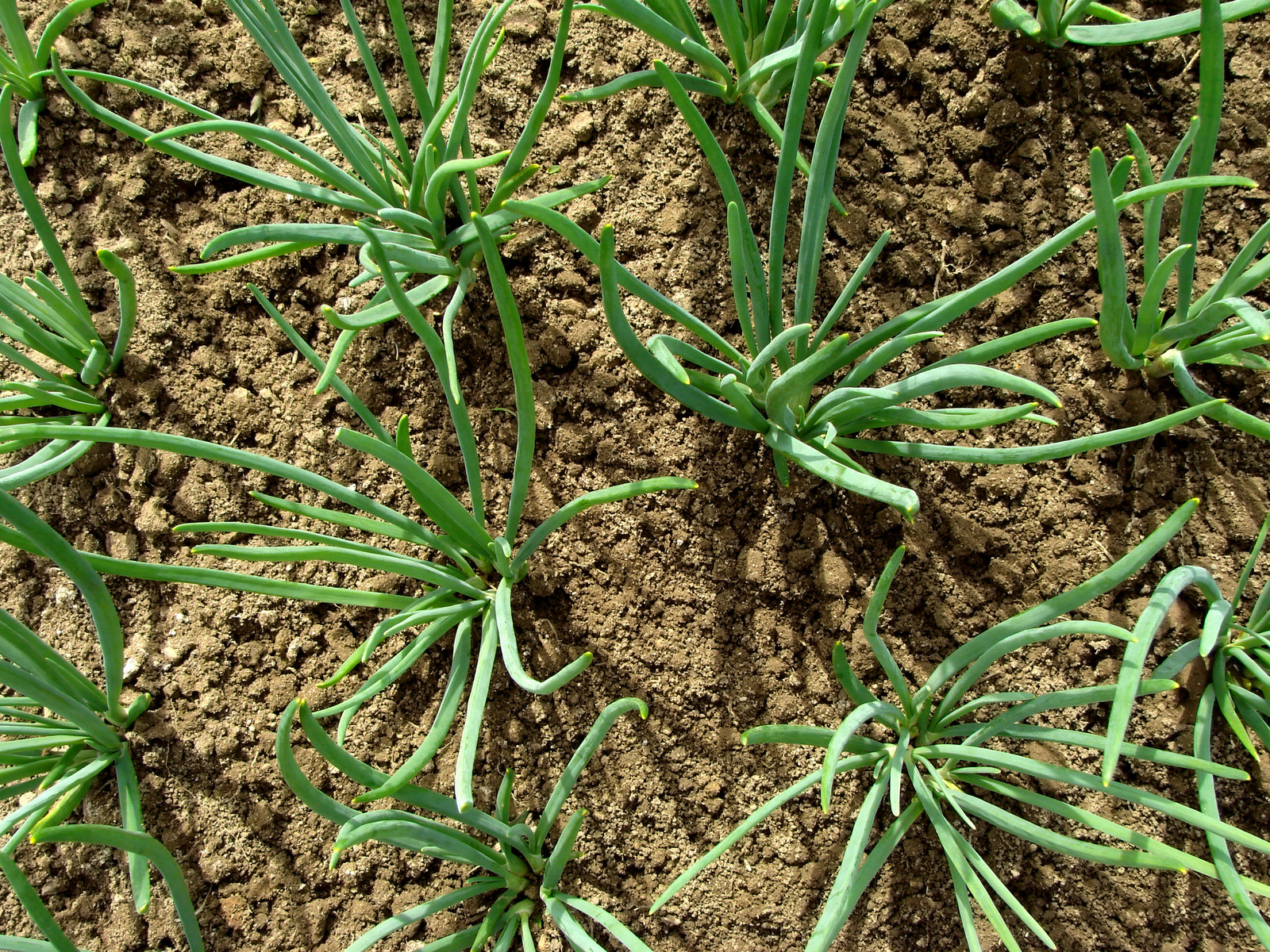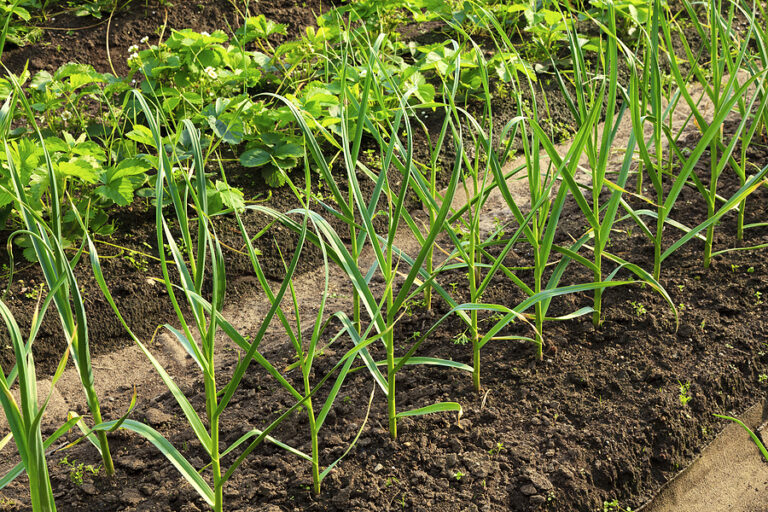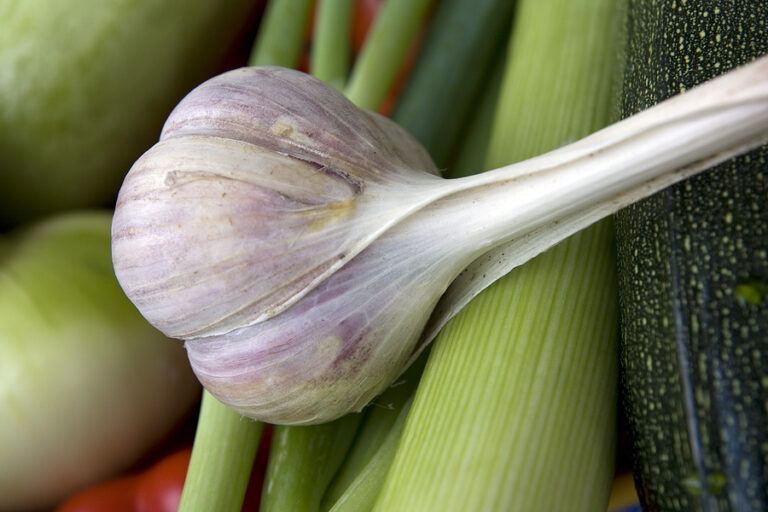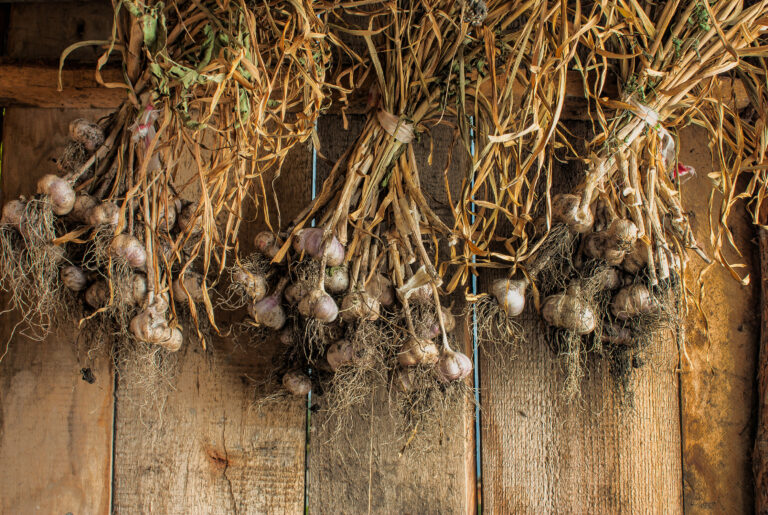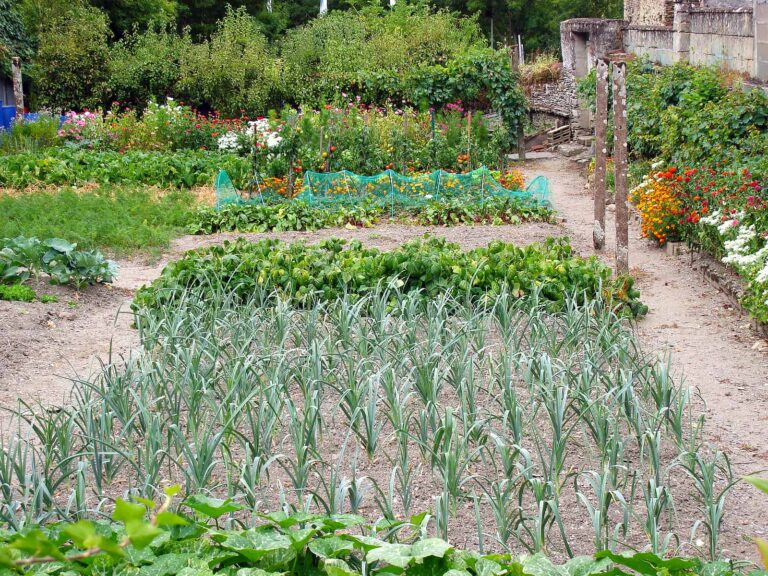Planting Onion Seeds and Sets
Onions can be grown from seeds, seedlings, or sets (young, small dormant bulbs grown the previous year).
Growing onions from seeds can take as long as five months. Growing onions from seedlings or transplants purchased from the garden center can take about two to four months.
Growing onions from sets will take about two months. Growing onion from sets is quicker than growing from seeds or seedlings.
Tools for Vegetable Gardeners at Amazon:
- All-Steel Nursery Spade with D-Grip Handle
- 4-Tine Spading Digging Fork with D-Handle
- Digital Soil pH Meter Outdoors Greenhouse
Growing onions from seeds will give the greatest selection of varieties. Growing from seedlings or sets is limited by the offerings of seed growers.
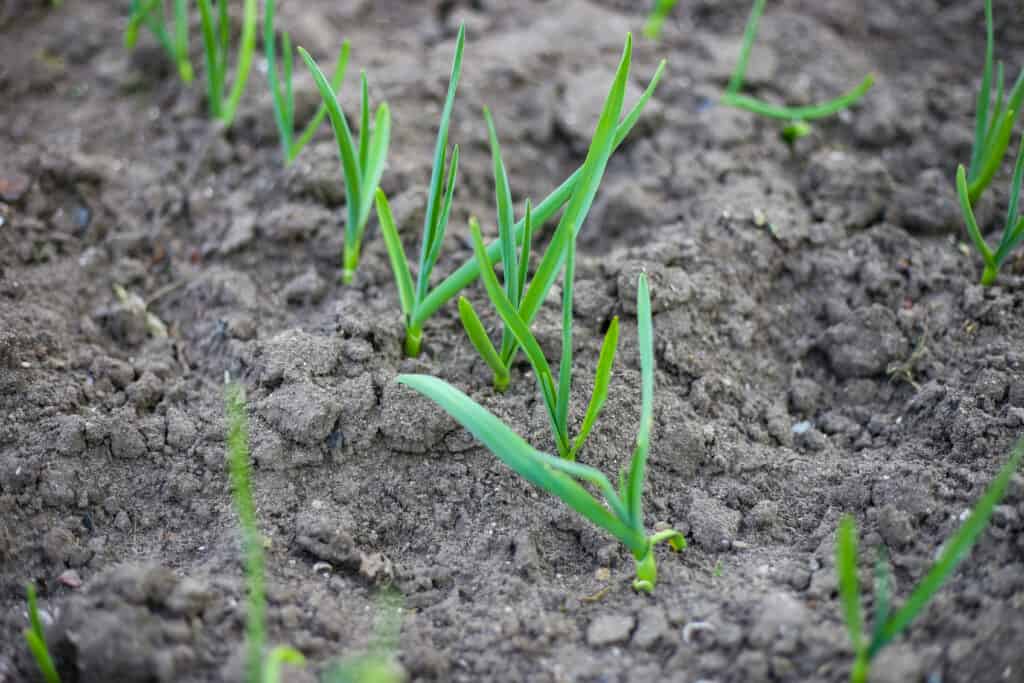
Onions can be harvested young as green onions or harvested mature as bulb onions. Growing bulb onions requires a long growing season—3 to 4 months. Onions mature in 95 to 115 days for bulbing onions depending on the variety, and about 60 to 70 days for green onions.
Onions are best planted in late winter or early spring for summer through autumn harvest. Green onions or scallions can be harvested about 2 months after seed sowing. Bulb onions can be harvested about four months after seed sowing.
Onion bulb formation and daylight
Onion bulb formation is influenced by the length of daylight and the hours of darkness each day. So-called long-day onions form bulbs when daylight grows longer in spring than the darkness of night. Short-day onions form bulbs when the hours of night and day are nearly equal or when nighttime hours are longer than daylight hours.
Onions for northern latitudes (in the Northern Hemisphere) are called long-day onions; they form bulbs when days grow long and nights are short. Long-day onions require long hours of daylight–14 to 16 hours per day–to reach maturity. Long-day onions grow best in northern latitudes.
Onions for growing closer to the equator—where summer nights are longer—are called short-day varieties. Short-day onions grow best in mild-winter southern latitudes. They grow through the fall and winter and form bulbs when daylight increases to 12 hours per day in early summer. (Onions will be slow to grow if temperatures linger in the 30°s and 40°sF.)
Plant long-day onion varieties in northern regions and short-day onion varieties in southern regions. If you live where days and nights are of equal length in summer, grow an intermediate variety.
Garden centers commonly carry the appropriate onion varieties for the gardeners in their region.
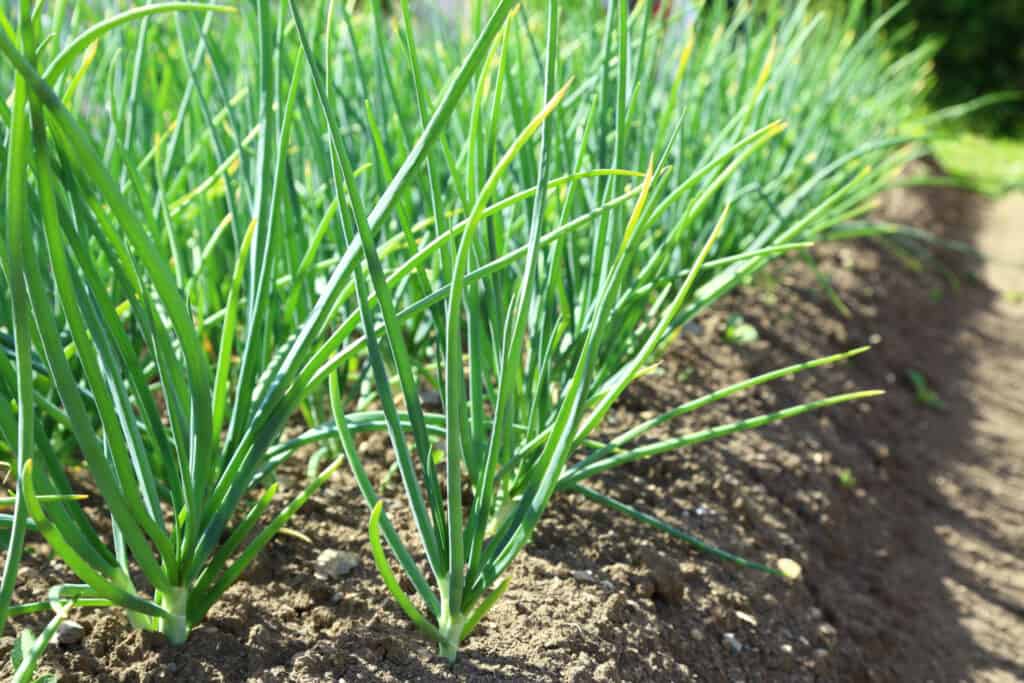
Sowing onions seeds
Sow onion seeds in the garden after all danger of frost has passed in spring and the soil is at least 55°F (13°C)—warmer is better. In warm-winter regions, plant onions outdoors in the fall. . Avoid sowing onion seed directly in the garden until the soil temperature has reached 50°F. Plant bulb onions in full sun. Green onions can be planted in partial shade.
Outdoors sow onion ½ inch deep and 1 inch apart. Later, thin to four inches apart for growing bulbs. For green or pulling onions, sow seed ¼ inch deep, 2 to 3 inches apart.
Start onion seeds indoors 8 to 12 weeks before transplanting seedlings to the garden. Sow seeds in pots, flats, or trays. Sow seeds in a warm, well-lighted location—in a bright window or under grow lights. Sow seeds 1/4″ (6 mm) deep in a seed starting mix. Firm lightly and keep the mix just moist. Seedlings emerge in 7-14 days at 60-85°F (16-29°C). Thin seedlings to one inch apart when they are four inches tall.
Onion seeds are very small and can be difficult to handle; it may be easier to start seeds indoors and transplant seedlings. However, onions started from seeds in the garden grow larger and store longer.
Outdoors onions grow best in loose, well-drained sandy loam. Turn lots of well-aged compost and manure into the onion bed in advance of planting; turn the soil to at least 8 inches deep. Sow onions in rich, well-drained soil with plenty of garden compost. Before planting, work the soil to a depth of six inches removing stone and lumps. Onions prefer a soil pH of 6.0 to 7.5. Acidic soil with a pH of less than 6.0 will result in a more pungent flavor. Add lime to the soil to make it less acidic. For green onions, add a handful of nitrogen-rich blood meal to each square yard or meter before planting.
To encourage the development of bulbs, soak sets in compost tea for about 15 minutes before planting. About four weeks after planting, gently push back the soil atop bulbs; this will help them to grow larger.
Onion seeds should germinate in 4 to 10 days at an optimal temperature of 70°F (21°C) or thereabouts; germination will take longer in colder soil but germination can be slow in chilly soil.
The optimum soil temperature to grow onions is 55°F to 75°F (13-24°C).
Onion seeds are viable for just 1 to 2 years.
Be sure to choose the correct variety for your day length. In the Northern Hemisphere, Southern gardeners should select Short Day varieties (10-12 hours of sunlight each day); Northern gardeners should select Long Day varieties (14-15 hours of sunlight each day); gardeners in between should select Intermediate Day varieties (13-14 hours of sunlight each day).

Planting onion sets
Onions grown from small bulbs are called “sets”. Plant onion sets 1 to 2 inches deep and 3 to 4 inches apart for green onions. For bulb onions, plant sets 6 to 8 inches apart. Space rows 12 to 18 inches apart. The final size of each onion bulb will depend on how much space it has to grow.
If you plant onions from sets, choose bulbs less than 1 inch (2.5 cm) in diameter; larger bulbs tend to flower sooner. Choose sets that have bulbs about ½ inch in diameter. (Larger sets may go to seed before producing decent-size bulbs. Sets with smaller bulbs may not grow well.)
Plant bulbs pointy end up; the rounded end is the rooting end. Set bulbs ½ to one inch deep and four to six inches apart–depending on the size of the bulb at maturity.
Onion sets are often labeled “red,” “white,” or “yellow”–you may not know the exact variety you are growing.
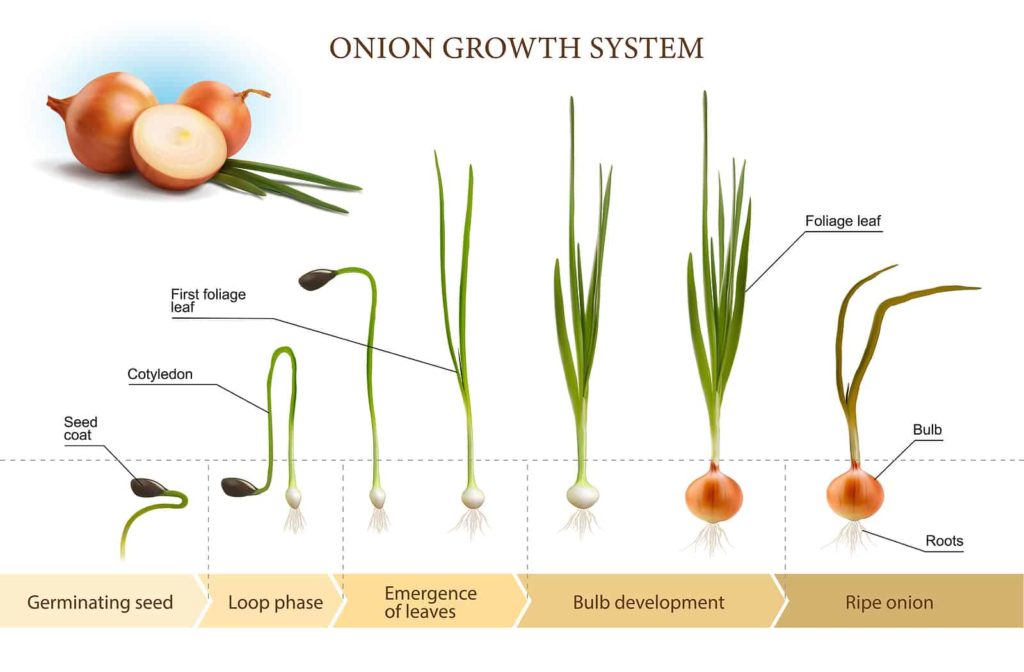
Growing onions from seedlings
Seedlings–also called starts or transplants– can be transplanted to the garden in early spring as soon as the soil can be worked–usually, about 2 to 3 weeks before the last frost when the soil temperature is at least 40°F and the air temperature should be at least 45°F.
Seedlings can be transplanted into the garden when they are 3 to 4 inches (7.5-10 cm) tall. Move seedlings to a sheltered place outdoors to “harden off” 1 week before transplanting. Space plants 3 to 5 inches (7.5-13 cm) apart for bulb onions, 2 to 3 inches (5-13 cm) apart for scallions, and bunching onions.
Set bulb onion seedlings one to two inches deep–depending on the size of the bulb–and four to six inches apart. Set seedlings being grown for green onions or scallions one inch apart.
Onions grown from transplants mature more quickly than onions grown from seed.
Grow onions in compost-rich, well-drained soil, in full sun. Give onions regular water keeping the soil evenly moist. Do not plant onion family crops in the same place for 2 years in a row.
Onion planting details
- Sowing depth: ½ inch (1.2 cm)
- Space between plant after thinning: 3-4 inches (7.6-10cm)
- Days to sprout: 10; start seed indoors 4 to 6 weeks before setting transplants in the garden
- Days to harvest: 95-130
- Storage period: 12-32 weeks
- Seeds per 100-row feet: ½ ounce (14 grams)
- Yield per 100-row feet: 100 pounds (45 kilos)
- Suggested varieties: Check at a garden center or call the cooperative extension for varieties suited to your location.
- Note: Control weeds while plants are spindly and defenseless.
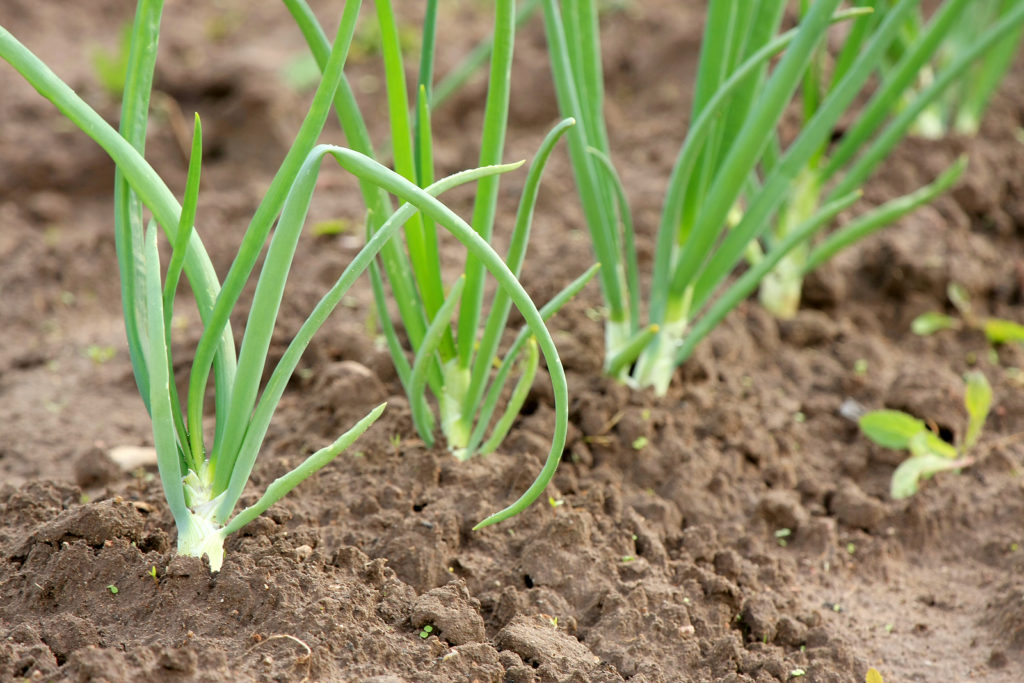
Onion seed planting time
Onions require cool weather to start growth and produce green leaves for green or spring onions and warm weather to produce mature bulbs. Onions seeds, seedlings, and sets are frost hardy. Onions started from seed indoors in late winter should form bulbs for summer harvest. Onions started from seed in the garden in mid to late spring can be grown as summer-bunching onions or fall-storage onions.
- Bulbing onions require 80 to 120 days to reach harvest.
- Green onions are harvested before they form bulbs, in 40 days or less.
- Spring onions form small, immature bulbs and are harvested in 40 to 60 days.
Spring planting
Plant onion seeds, seedlings, and sets in early spring in northern and cold-winter regions for harvest the following autumn after they have formed bulbs. Sow seeds directly in the garden as early as six weeks before the average last frost date, or start seed earlier in late winter in a greenhouse or cold frame and transplant seedlings to the garden in early spring.
- 10-12 weeks before the last frost in spring: direct-sow scallions and onions in a plastic tunnel or cold frame, or sow indoors for transplanting into the garden 6 to 4 weeks before the last frost in spring.
- 4-6 weeks before the last frost in spring when the soil is workable: direct-sow onion and scallion seeds and sets in the garden; transplant onion seedlings to the garden.
For fall and winter harvests of green onions and scallions
- 8-10 weeks before the first frost in fall: direct-sow green onions and scallions in the garden and under a plastic tunnel or cold frame.
Onion planting dates for summer harvest
(These dates are for the Northern Hemisphere)
| Average date of the last frost | Planting dates |
| Jan. 30 | Jan. 1-15 |
| Feb. 8 | Jan. 1-15 |
| Feb. 18 | Jan. 1-15 |
| Feb. 28 | Jan. 1-Feb. 1 |
| Mar. 10 | Jan. 15-Feb. 15 |
| Mar. 20 | Feb. 10-Mar. 10 |
| Mar. 30 | Feb. 20-Mar. 15 |
| Apr. 10 | Mar. 1-Apr. 1 |
| Apr. 20 | Mar. 1-Apr. 1 |
| Apr. 30 | Mar. 15-Apr. 15 |
| May 10 | Apr. 1-May 1 |
| May 20 | Apr. 20-May15 |
| May 30 | May 1-30 |
| June 10 | May 10-June 10 |
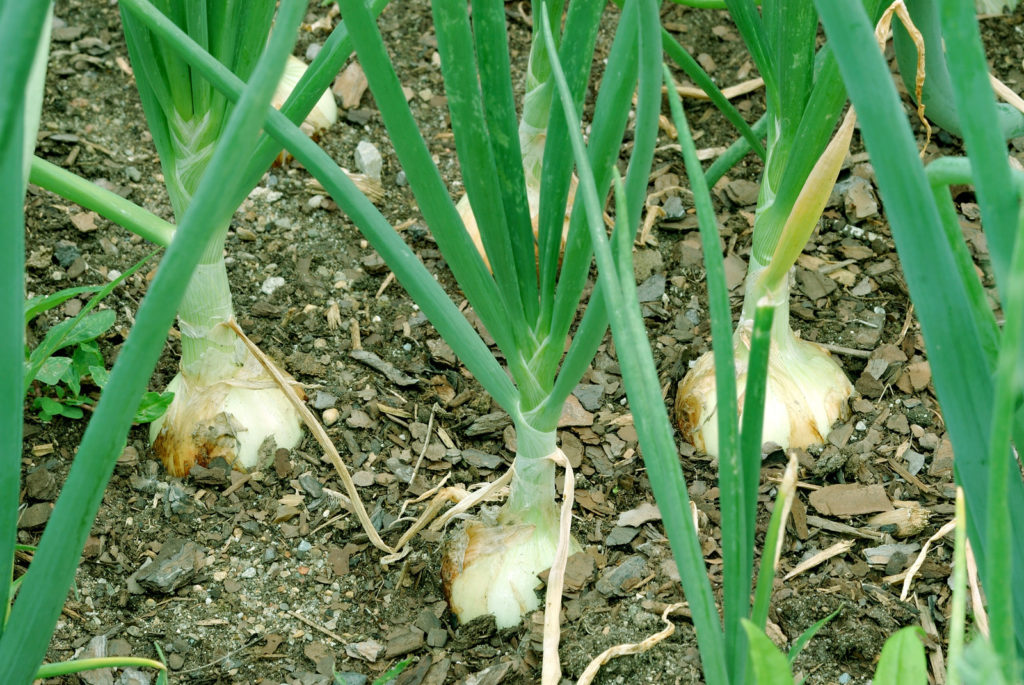
Onion plant care
Food and water
Onions are heavy feeders. Feed onions with a rich fertilizer, such as fish emulsion, early in the season to develop large plants and bulbs. (Or you can use organic fertilizer, 5-10-10.) Give a second feeding about a month after the first feeding or side-dress rows with a band of aged compost. Keep onions evenly watered early in the season. They require constant moisture during the bulb enlargement stage; dry conditions early on will cause bulbs to split. Give each plant about 1 inch of water each week (about 1.6 gallons). Transplants require more water than sets. At midsummer–or about a month before harvest after bulbs have formed and when the necks of the onions begin to soften, cut back on food and water and allow bulbs to mature in drier, less fertile soil.
Weeding
Keep onion beds well-weeded. Onions are shallow-rooted. Cultivate often and shallowly. Pull weeds by hand close to bulbs to avoid up-turning plants. Use a sharp hoe only to cut off weeds at the soil level. Because onion leaves are thin and strappy they do not block the sun from the soil which, in turn, allows weed germination. Onion beds require more weeding than other vegetable beds.
Mulch
After the soil has warmed, place a 1- to 2-inch layer of mulch around onions to discourage weeds and conserve soil moisture. Use aged compost or chopped leaves around onions. Keep the mulch back from bulb tops once they start to develop. (To grow large onions, keep both mulch and soil pulled back from the top two-thirds of developing bulbs.)
General tips
- High soil nitrogen will delay bulbing—as will temperatures too cool.
- Onions grown in potassium-deficient soil will not store well; onions grown in phosphorus-deficient soil will have thick necks and mature more slowly.
- Keep the planting beds free of weeds to avoid competition for moisture and nutrients.
- Avoid planting onions where garlic or leeks have grown recently.
- Fertilize with an organic fertilizer such as fish emulsion at half strength.
- Water onions until the bulbs swell. Let the soil dry out once bulbs have formed and the leaves begin to yellow and droop
- Common pest enemies include Japanese beetles, onion eelworms, onion maggots, slugs, thrips, and wireworms. Protect seedlings from pests and cold temperatures for two to three weeks after planting in the garden by covering seedlings with spun poly-row covers.
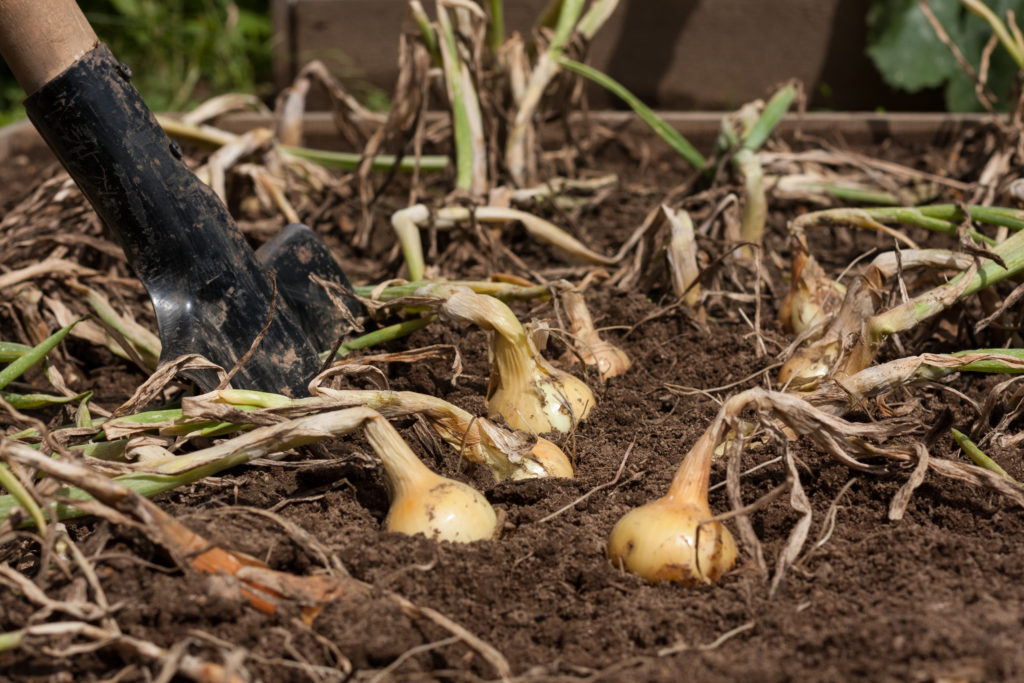
Onion harvest and storage
Harvest
Bulb onions are ready for harvest 80-120 days after seeding, 30 to 40 days from sets (small bulbs). Harvest green onions when they are 6-8” inches (15-20 cm) tall. Hasten the harvest of bulb onions by bending stalks to the ground (called “lodging”) about 100 days after sowing, when the tops have begun to turn yellow and fall over. A few days later lift bulbs and allow to dry (“cure”) in the garden covered or indoors in a warm, dry place with good air circulation for 1-2 weeks. Then cut the foliage about 1” (2.5 cm) above the bulb and store in a cool, dry location.
New growth from the center will stop when bulbs start forming. When bulbs are ripe, leaves will begin to yellow and fall over. After about three-quarters of the tops have fallen over, use the back of a rake to horizontally bend over the remaining tops. The bent leaves will cause the plant to divert the rest of its energy to the bulbs and away from leafy growth. After the tops turn brown in a day or two, lift the bulbs with a garden fork on a sunny day, and leave them to dry in the sun. When bulb outer skins are dry and the tops withered in about a week, wipe off any soil, and cut away the tops. If the weather is damp, allow the onions to dry in an airy place. You can loop the leaves through the mesh of a fence or framed chicken wire or braid them into a garland to dry.
Storing
Keep onions in a cool, dry place to prevent rotting. Hang them in mesh bags or braids. Cured onion bulbs will store from one month to a year depending on the variety.
Onion Types and Classifications
There are many types of onions to choose from and grow. Select bulb or bunching onions depending upon your intended use. Bulb onions can range from small pearl onions to very large Spanish types. Bulbs are white, yellow, or red at harvest. Bunching onions–also called scallions or green onions–are grown for their tender, green top stalks. They are harvested before bulbs fully form.
Onion color classifications
- Yellow or golden varieties: best for storing, early to harvest in mid-summer.
- Red: sweet-tasting, early to harvest in mid-summer.
- White: mild flavored.
Other classifications
- Long storing: choose America type, yellow, white, or red.
- Tiny and round: choose pearl or pickling onions.
- Large, sweet for slicing: choose Bermuda or Spanish onions.
- Scallions: harvest at scallions size or grow bunching onions.
- Multiplier onions: also called potato onions; produce a cluster of small to medium size bulbs joined at the base. Plant from sets in late summer.
Day-length classifications
- Short-day: requires an equal amount of darkness and light (about 10-12 hours) to set bulbs; best grown in southern regions of the Northern Hemisphere; varieties include ‘Bermuda’, ‘California Red’, ‘Granex’, and ‘Grano Super Sweet’.
- Long-day: requires 14 to 15 hours of light and 9-10 hours of darkness; varieties include: ‘Early Yellow Globe’, ‘Ebeneezer’, ‘Ruby’, and ‘Sweet Spanish’.
- Intermediate-day-length: requires about 13 to 14 hours of daylight to form a bulb; varieties include ‘Red Torpedo’, and ‘Ringmaker’.
Botanical Name: Allium cepa. Onions are a member of the Alliaceae also called the Lilliaceae family, other members of this family include garlic and leeks.
Onion Growing Hub
Start here: The Ultimate Onion Growing Guide: From Seed to Harvest
🌱 Planning & Varieties
- How to Choose the Best Onion Varieties for Your Region – Match flavor, storage, and climate to your garden.
- Daylength and Onion Growth: Understanding Short, Intermediate, and Long-Day Varieties – Pick the right type for your latitude.
- Growing Bulb Onions: Pick the Right Variety for Your Garden – Choose the right variety for where you live.
- Onion Sets vs. Seedlings vs. Seeds: Which Is Best for Your Garden? – Pros and cons of each planting method.
🌿 Planting & Starting
- Step-by-Step Guide to Starting Onion Seeds Indoors Successfully – Timing and troubleshooting for strong transplants.
- Planting Onions Seeds and Sets – Here’s how to get started.
- How to Grow Onion Sets – You can grow your own onion sets from seed for next year.
- Growing Onions in Containers: Soil, Pots, and Care Tips – Small-space planting success.
- How to Grow Green Onions, Spring Onions, and Scallions – Learn how these alliums differ.
- How to Plant, Grow, and Harvest Welsh Onions – Learn to grow these mild-flavored members of the onion family.
🌞 Care & Maintenance
- Watering Onions for Optimal Growth: Techniques and Tips – How much and how often to water.
- Feeding and Fertilizing Onions: Organic and Synthetic Options – Nutrient needs for strong bulbs.
- Companion Planting with Onions: Plants to Grow With and Avoid – Beneficial pairings and plants to avoid.
- Onion Family Growing Problems: Pest, Disease, and Problem Controls – Natural control of thrips, maggots, and more; identifying and treating fungal or bacterial problems.
🧅 Harvest & Storage
- How to Harvest Onions at Peak Maturity for Best Storage – Signs onions are ready and how to cure.
- How to Harvest and Store Onions – Here are the basics for harvesting and storing onions.
- Onion Storage Techniques: Keep Your Harvest Fresh for Months – Best environments for long-term keeping.
🍳 Using Your Onions
- Cooking with Onions: Recipes and Tips to Bring Out Flavor – From fresh salads to caramelized dishes.
- How to Make Onion Soup with No Recipe – Enjoy this tasty classic!
Also of interest:
How to Plant, Grow, and Harvest Onions
How to Plant, Grow, and Harvest Scallions
How to Plant, Grow, and Harvest Welsh Onions
Onion articles at Harvest to Table:
How to Grow Green Onions, Spring Onions, and Scallions
Growing Onion Bulbs: Pick the Right Variety for Your Garden
How to Plant, Grow, and Harvest Welsh Onions
How to Harvest and Store Onions
Onion Family Growing Problems: Troubleshooting
Onion Cooking and Serving Tips
Tasty Ways to Cook and Serve Shallots
How to Make Onion Soup with No Recipe
How to Plant, Grow, and Harvest Shallots
English Peas, Spring Onions and Roasted Almonds
Tropea Onion – The Red Torpedo
Garden Planning Books at Amazon:

